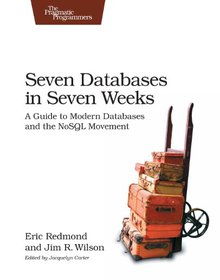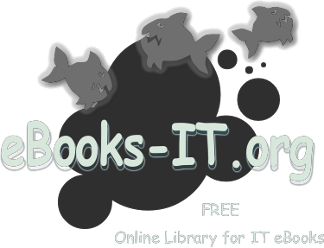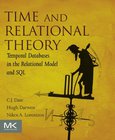Seven Databases in Seven Weeks
A Guide to Modern Databases and the NoSQL Movement

Book Details:
| Publisher: | Pragmatic Bookshelf |
| Series: | Pragmatic Bookshelf , Modern |
| Author: | Jim R. Wilson |
| Edition: | 1 |
| ISBN-10: | 1934356921 |
| ISBN-13: | 9781934356920 |
| Pages: | 352 |
| Published: | May 21 2012 |
| Posted: | Nov 19 2014 |
| Language: | English |
| Book format: | |
| Book size: | 6.57 MB |
Book Description:
Data is getting bigger and more complex by the day, and so are the choices in handling that data. As a modern application developer you need to understand the emerging field of data management, both RDBMS and NoSQL. Seven Databases in Seven Weeks takes you on a tour of some of the hottest open source databases today. In the tradition of Bruce A. Tate's Seven Languages in Seven Weeks, this book goes beyond your basic tutorial to explore the essential concepts at the core each technology. Redis, Neo4J, CouchDB, MongoDB, HBase, Riak and Postgres. With each database, you'll tackle a real-world data problem that highlights the concepts and features that make it shine. You'll explore the five data models employed by these databases-relational, key/value, columnar, document and graph-and which kinds of problems are best suited to each. You'll learn how MongoDB and CouchDB are strikingly different, and discover the Dynamo heritage at the heart of Riak. Make your applications faster with Redis and more connected with Neo4J. Use MapReduce to solve Big Data problems. Build clusters of servers using scalable services like Amazon's Elastic Compute Cloud (EC2). Discover the CAP theorem and its implications for your distributed data. Understand the tradeoffs between consistency and availability, and when you can use them to your advantage. Use multiple databases in concert to create a platform that's more than the sum of its parts, or find one that meets all your needs at once. Seven Databases in Seven Weeks will take you on a deep dive into each of the databases, their strengths and weaknesses, and how to choose the ones that fit your needs.What You Need: To get the most of of this book you'll have to follow along, and that means you'll need a *nix shell (Mac OSX or Linux preferred, Windows users will need Cygwin), and Java 6 (or greater) and Ruby 1.8.7 (or greater). Each chapter will list the downloads required for that database.
Download Link:
Related Books:
Time and Relational Theory
Temporal Databases in the Relational Model and SQL
Time and Relational Theory provides an in-depth description of temporal database systems, which provide special facilities for storing, querying, and updating historical and future data. Traditionally, database management systems provide little or no special support for temporal data at all. This situation is changing because: * Cheap storage enables retention of large volumes of historical data in data warehouses* Users are now faced with temporal data problems, and need solutions * Temporal features have recently been incorporated into the SQL standard, and vendors have begun to add temporal support to their DBMS products Based on the groundbreaking text Temporal Data & the Relational Model (Morgan Kaufmann, 2002) and new research led by the au...
The Language of SQL
How to Access Data in Relational Databases
Most SQL texts attempt to serve as an encyclopedic reference on SQL syntax -- an approach that is counterproductive, since this information is readily available in online references published by the major database vendors. For SQL beginners, it's more important for a book to focus on general concepts and offer clear explanations and examples of what the various statements can accomplish. This is that beginner book. A number of features make The LANGUAGE OF SQL unique among introductory SQL books. First, you will not be required to download software or sit with a computer as you read the text. The intent of this book is to provide examples of SQL usage that can be understood simply by reading them. Second, topics are organized in an intuitive and logi...
Sequence Analysis in a Nutshell
A Guide to Common Tools and Databases
Gene sequence data is the most abundant type of data available, and if you're interested in analyzing it, you'll find a wealth of computational methods and tools to help you. In fact, finding the data is not the challenge at all; rather it is dealing with the plethora of flat file formats used to process the sequence entries and trying to remember what their specific field codes mean. If you survive by surrounding yourself with well-thumbed hard copies of readme files or remembering exactly where to look for the details when you need them, then Sequence Analysis in a Nutshell: A Guide to Common Tools and Databases is for you. This book is a handy resource, as well as an invaluable reference, for anyone who needs to know about the practical aspects an...
2007 - 2021 © eBooks-IT.org



